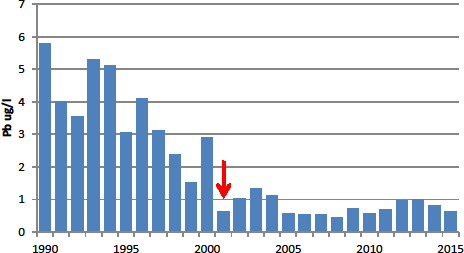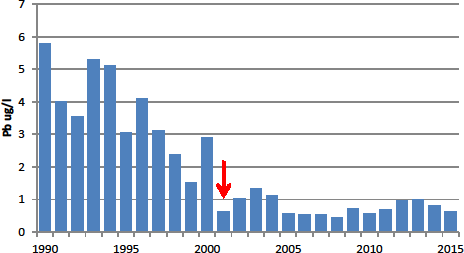Stonemasonry in the Říčany Region – Lesní potok, Part 2

Barbora Dudíková Schulmannová, Vojtěch Janoušek, Tomáš Navrátil, Václav Rybařík and Pavel Vlašímský
As regards the quality of surface water in Lesní potok, which in fact reflects the reaction of precipitation with soil in the environment, we have noted several improvements. First of all, due to the decrease of acidity of rainfall, the outflow of basic cations, i.e. loss of Ca, Mg and K from the soil, has also decreased. These elements represent important nutrients for trees and plants. Decreasing pH of surface water has resulted in a decrease in the concentration of toxic elements, such as aluminium, cadmium, or beryllium.

Figure 5:
Decrease in the occurrence of Pb in the atmosphere recorded by means of average annual concentration of Pb in µg/l in precipitation in open area from 1990 to 2015. The red arrow marks the year 2001 when the sale of leaded petrol was banned in the CR.
Figure 5: Decrease in the occurrence of Pb in the atmosphere recorded by means of average annual concentration of Pb in µg/l in precipitation in open area from 1990 to 2015. The red arrow marks the year 2001 when the sale of leaded petrol was banned in the CR.
Another interesting phenomenon observed in the Lesní potok basin was a significant decrease in lead deposition after 2000. Lead emissions in the CR considerably decreased as a result of a ban on the sale of leaded petrol that came into force on 1 January 2001. The time span of substance flow monitoring in the Lesní potok basin and the surrounding area thus covers a period before the ban on tetraethyl lead and continues for a number of years after the ban. The results therefore clearly demonstrate how a decrease in emissions affects depositions, and as such they justify the investments in environmental measures to improve the state of the environment. The course of Pb deposition in open area was monitored between the years 1990 and 2015. The average concentration of Pb in precipitation in open area between 1990 and 1994 ranged from 3.5 to 5.8 µg/l. The average annual Pb concentration in precipitation in open area in the given period was gradually falling as the market share of unleaded petrol decreased. The decrease in Pb deposition could have been partially caused also by the desulphurization of thermal power plants, which lasted until 1999.
In conclusion, monitoring a small river basin is a time-consuming, laborious, and financially demanding process. To illustrate, between the years 1994 to 2015 the researchers took 252 monthly field trips in all weathers to collect samples, and they took dozens of irregular maintenance trips or trips to collect additional samples. In total, they collected over 1,500 samples including rainfall, surface, soil, and groundwater samples.
